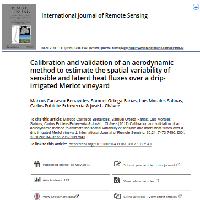Resumen
- A study was carried out to calibrate and validate the aerodynamic temperature method for estimating the spatial variability of the sensible (H) and latent (LE) heat fluxes over a drip-irrigated merlot vineyard located in the Maule Region, in Chile. For this study, measurement of energy balance components and meteorological data were collected from the 2006 to 2010 growing seasons. The experimental plot was composed of a 4.25 ha of 'Merlot' vineyard, which was equipped with an Eddy-Covariance system and an automatic weather station. The k-fold cross-validation method was utilized to tune and validate a vineyard surface aerodynamic temperature (T-aero) model, considering all of the days when Landsat scenes and ground measurements of meteorological data and surface energy balance (SEB) were available. Then, the satellite-based estimations of Taero were utilized to calculate the surface aerodynamic resistance (r(ah)) and, subsequently, heat fluxes of H and LE. Results indicated that the estimated H and rah values were not significantly different to those measured in the vineyard (95% significance level) showing a root mean square (RMSE) and mean absolute error (MAE) between 34-29 W m(-2) and 1.01-0.78 s m(-1), respectively. Satellite-based computations of LE were somewhat higher than those measured at the time of satellite overpass (RMSE = 63 W m(-2); MAE = 56 W m(-2)), presumably due to the biases embedded in the net radiation (R-n) and soil heat flux (G) computations. The proposed SEB method based on T-aero is very simple to implement, presenting similar accuracies on ET mapping to those computed by complex satellite-based models.
